【教案与学案】高考英语听力训练与解题技巧指导(Ⅰ) 学案
- 格式:doc
- 大小:41.00 KB
- 文档页数:4
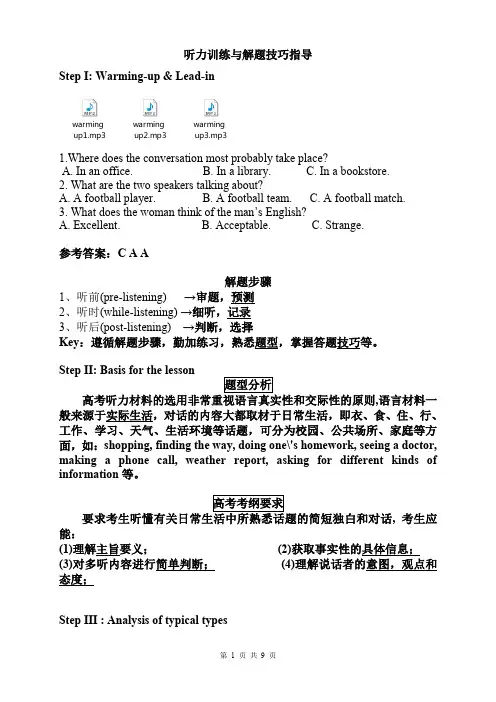
听力训练与解题技巧指导Step I: Warming-up & Lead-inwarming up1.mp3warmingup2.mp3warmingup3.mp31.Where does the conversation most probably take place?A. In an office.B. In a library.C. In a bookstore.2. What are the two speakers talking about?A. A football player.B. A football team.C. A football match.3. What does the woman think of the man’s English?A. Excellent.B. Acceptable.C. Strange.参考答案:C A A解题步骤1、听前(pre-listening) →审题,预测2、听时(while-listening) →细听,记录3、听后(post-listening) →判断,选择Key:遵循解题步骤,勤加练习,熟悉题型,掌握答题技巧等。
Step II: Basis for the lesson,语言材料一般来源于实际生活,对话的内容大都取材于日常生活,即衣、食、住、行、工作、学习、天气、生活环境等话题,可分为校园、公共场所、家庭等方面,如:shopping, finding the way, doing one\'s homework, seeing a doctor, making a phone call, weather report, asking for different kinds of information等。
, 考生应能:(1)理解主旨要义;(2)获取事实性的具体信息;(3)对多听内容进行简单判断;(4)理解说话者的意图,观点和态度;Step III : Analysis of typical types常见提问形式有:Where does / did this conversation probably take place?Where are the two speakers?Where can you see such plants?题型特点:此类题的书面选项大都是表示地点或方向的介词短语,主要考查分析推理能力,即根据对话所提供的信息,推断出对话所发生的地点和场景。
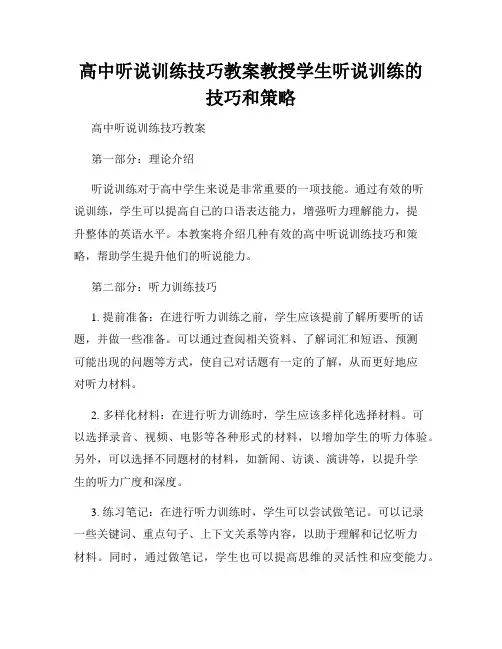
高中听说训练技巧教案教授学生听说训练的技巧和策略高中听说训练技巧教案第一部分:理论介绍听说训练对于高中学生来说是非常重要的一项技能。
通过有效的听说训练,学生可以提高自己的口语表达能力,增强听力理解能力,提升整体的英语水平。
本教案将介绍几种有效的高中听说训练技巧和策略,帮助学生提升他们的听说能力。
第二部分:听力训练技巧1. 提前准备:在进行听力训练之前,学生应该提前了解所要听的话题,并做一些准备。
可以通过查阅相关资料、了解词汇和短语、预测可能出现的问题等方式,使自己对话题有一定的了解,从而更好地应对听力材料。
2. 多样化材料:在进行听力训练时,学生应该多样化选择材料。
可以选择录音、视频、电影等各种形式的材料,以增加学生的听力体验。
另外,可以选择不同题材的材料,如新闻、访谈、演讲等,以提升学生的听力广度和深度。
3. 练习笔记:在进行听力训练时,学生可以尝试做笔记。
可以记录一些关键词、重点句子、上下文关系等内容,以助于理解和记忆听力材料。
同时,通过做笔记,学生也可以提高思维的灵活性和应变能力。
第三部分:口语训练技巧1. 模仿练习:模仿是提高口语能力的一种有效方式。
学生可以选择自己喜欢的英语口语节目或者优秀的英语演讲,模仿其中的语音、语调、语速等特点,从而提高自己的口语表达能力。
可以通过录音自我对比,找出自己的不足之处并加以改进。
2. 角色扮演:角色扮演是一种锻炼口语能力的有趣方式。
学生可以分成小组,每个人扮演不同的角色,在特定的情境中进行对话练习。
通过模拟真实的交际场景,学生可以更好地应对各种口语表达需求,锻炼口语灵活性和语言应对能力。
3. 辩论训练:辩论是一种锻炼口语能力和思维能力的好方法。
学生可以分成两个小组,通过就一个议题展开辩论,提高自己的语言组织、逻辑思维和辩论技巧。
通过辩论训练,学生可以提升口头表达能力和争论技巧,同时增强自信心。
第四部分:教学示范和实践1. 教师示范:教师可以通过给学生展示标准的听说训练技巧和策略来帮助学生理解和掌握。
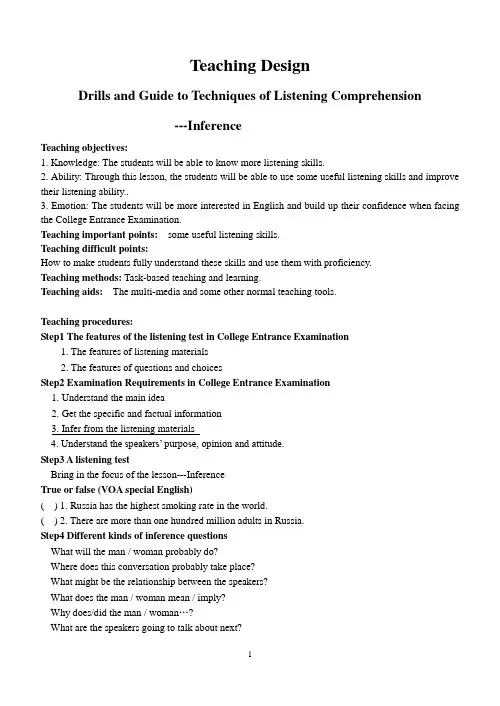
Teaching DesignDrills and Guide to Techniques of Listening Comprehension---InferenceTeaching objectives:1. Knowledge: The students will be able to know more listening skills.2. Ability: Through this lesson, the students will be able to use some useful listening skills and improve their listening ability..3. Emotion: The students will be more interested in English and build up their confidence when facing the College Entrance Examination.Teaching important points: some useful listening skills.Teaching difficult points:How to make students fully understand these skills and use them with proficiency.Teaching methods: Task-based teaching and learning.Teaching aids: The multi-media and some other normal teaching tools.Teaching procedures:Step1 The features of the listening test in College Entrance Examination1. The features of listening materials2. The features of questions and choicesStep2 Examination Requirements in College Entrance Examination1. Understand the main idea2. Get the specific and factual information3. Infer from the listening materials4. Understand the speakers’ purpose, opinion and attitude.Step3 A listening testBring in the focus of the lesson---InferenceTrue or false (VOA special English)( ) 1. Russia has the highest smoking rate in the world.( ) 2. There are more than one hundred million adults in Russia.Step4 Different kinds of inference questionsWhat will the man / woman probably do?Where does this conversation probably take place?What might be the relationship between the speakers?What does the man / woman mean / imply?Why does/did the man / woman…?What are the speakers going to talk about next?Step5 The barriers of inference in listening tests1.The factor of ability2.The factor of psychologyStep6 Listening instructions1. Adjust the mood and keep a good state of mind2. Skim and predict3. Grasp the key words and ignore the useless information4. Use all senses together and shorthandStep7 Consolidation --- Do more exercises ---Multiple choice1. 2012 / 2At what time will the film begin?A.7:20B.7:15C.7:002. 2012 / 4What will the woman probably do?A. Catch a train.B. See the man off.C. Go shopping.3. 2011 / 6Where is Ben?A. In the kitchen.B. At school.C. In the park.4. 2011 / 7What will the children do in the afternoon?A. Help set the table.B. Have a party.C. Do their homework.5. 2012 / 8What did the man think of the meal?A. Just so-so.B. Quite satisfactory.C. A bit disappointing.6. 2011 / 11Why does the man say that he would keep away from babies?A. He has just become a father.B. He wears dirty clothes.C. He is a smoker.Step8 Some more ways of practising listeningBlank-filling (BBC News) ---If time permitsThe Chinese writer Mo Yan has won the Nobel Prize for literature, the ______ time a writer working in _________ China has been _________ by the Swedish academy. Many of his works _________ the hardship and brutality (残暴) of the tumultuous (骚动的) ____________ in China. Mo Yan said he was _________ to have won the prize.Step9 SummaryBlackboard design:moodInference skim and predictkey wordsall senses, shorthand。
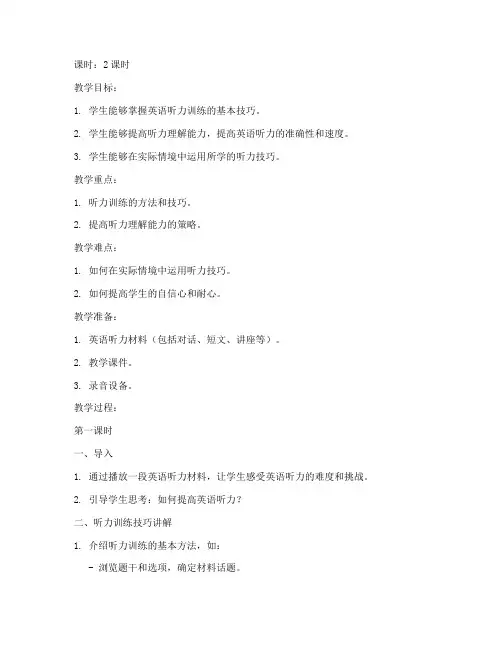
课时:2课时教学目标:1. 学生能够掌握英语听力训练的基本技巧。
2. 学生能够提高听力理解能力,提高英语听力的准确性和速度。
3. 学生能够在实际情境中运用所学的听力技巧。
教学重点:1. 听力训练的方法和技巧。
2. 提高听力理解能力的策略。
教学难点:1. 如何在实际情境中运用听力技巧。
2. 如何提高学生的自信心和耐心。
教学准备:1. 英语听力材料(包括对话、短文、讲座等)。
2. 教学课件。
3. 录音设备。
教学过程:第一课时一、导入1. 通过播放一段英语听力材料,让学生感受英语听力的难度和挑战。
2. 引导学生思考:如何提高英语听力?二、听力训练技巧讲解1. 介绍听力训练的基本方法,如:- 浏览题干和选项,确定材料话题。
- 根据关键词锁定材料信息。
- 重点关注材料的首句和尾句。
- 从记忆中重拾材料原文,根据前后题干有联系的选择选项。
2. 讲解听力技巧,如:- 识别音素,提高对语音的敏感度。
- 了解连读规律,提高对快速语音的识别能力。
- 练习听力速度,逐步提高听力速度。
三、听力练习1. 分组练习,每组选取一篇听力材料进行练习。
2. 教师巡视指导,解答学生疑问。
四、总结与反馈1. 学生分享练习心得,教师进行点评和总结。
2. 强调听力训练的重要性,鼓励学生坚持练习。
第二课时一、复习上节课所学的听力技巧1. 通过提问的方式,让学生回顾上节课所学的听力技巧。
2. 学生分组讨论,分享自己的听力技巧。
二、实际情境中的听力技巧运用1. 播放一段英语听力材料,让学生尝试运用所学的听力技巧。
2. 教师巡视指导,解答学生疑问。
三、小组合作听力练习1. 将学生分成若干小组,每组选取一篇听力材料进行合作练习。
2. 小组成员分工合作,共同完成听力任务。
四、总结与反馈1. 学生分享练习心得,教师进行点评和总结。
2. 鼓励学生在日常生活中多听、多说,提高英语听力水平。
教学评价:1. 通过学生的课堂表现和练习情况,评价学生对听力技巧的掌握程度。
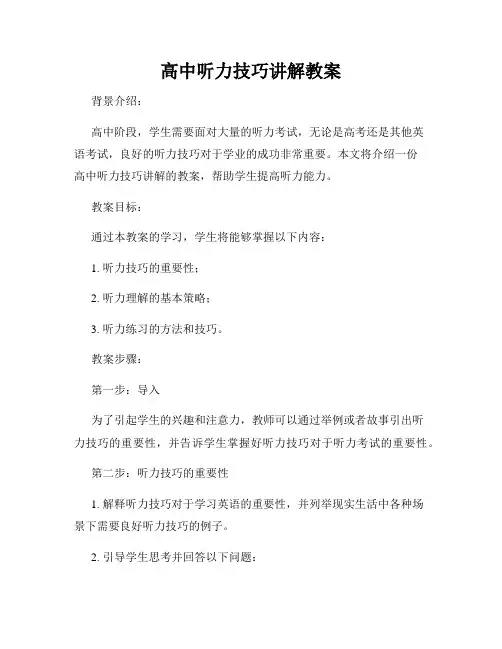
高中听力技巧讲解教案背景介绍:高中阶段,学生需要面对大量的听力考试,无论是高考还是其他英语考试,良好的听力技巧对于学业的成功非常重要。
本文将介绍一份高中听力技巧讲解的教案,帮助学生提高听力能力。
教案目标:通过本教案的学习,学生将能够掌握以下内容:1. 听力技巧的重要性;2. 听力理解的基本策略;3. 听力练习的方法和技巧。
教案步骤:第一步:导入为了引起学生的兴趣和注意力,教师可以通过举例或者故事引出听力技巧的重要性,并告诉学生掌握好听力技巧对于听力考试的重要性。
第二步:听力技巧的重要性1. 解释听力技巧对于学习英语的重要性,并列举现实生活中各种场景下需要良好听力技巧的例子。
2. 引导学生思考并回答以下问题:- 为什么听力技巧对于高中英语学习至关重要?- 学生能通过哪些途径提高听力技巧?第三步:听力理解的基本策略1. 向学生介绍常见的听力理解策略:- 预测:通过提供题目或者关键词,让学生在听力开始前猜测内容。
- 获取关键信息:学生要学会辨别和提取关键信息。
- 注意上下文:通过上下文推测单词或句子的含义。
- 留意关系词:注意关系词的使用,以理解句子之间的逻辑关系。
- 注意记号词:学习听力中常用的标志词和转折词,例如“however”、“therefore”等。
- 练习预测猜测:通过练习提前猜测答案。
2. 告诉学生如何在实际听力材料中运用这些策略,并提供示例。
第四步:听力练习的方法和技巧1. 向学生介绍几种有效的听力练习方法:- 多听多练:多听英文录音材料,例如英语新闻、音乐、影视剧等。
- 听后复述:听完一段材料后,学生尝试用自己的话复述所听到的内容。
- 听力填空:提供一段有空白部分的听力材料,学生根据所听到的内容填写答案。
- 听力理解课堂活动:组织学生进行听力理解小组讨论和角色扮演活动。
第五步:总结与反思让学生总结今天学习到的听力技巧,并分享自己的实践经验。
教师也可以提供一些其他的建议和资源,以帮助学生更好地提高听力能力。
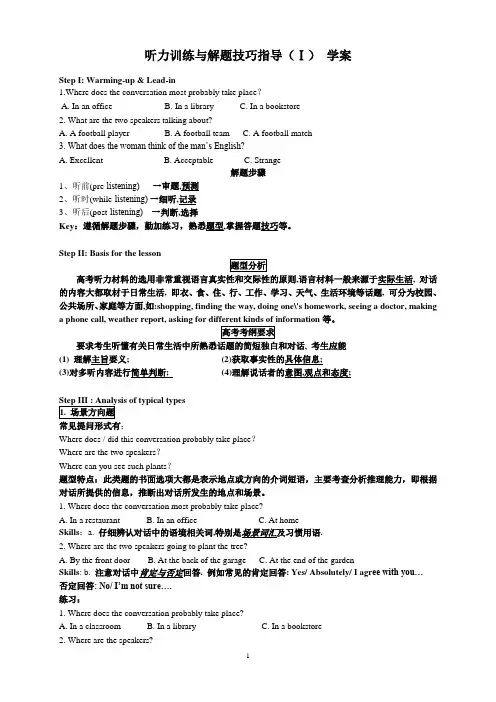
听力训练与解题技巧指导(Ⅰ)学案Step I: Warming-up & Lead-in1.Where does the conversation most probably take place?A. In an officeB. In a libraryC. In a bookstore2. What are the two speakers talking about?A. A football playerB. A football teamC. A football match3. What does the woman think of the man’s English?A. ExcellentB. AcceptableC. Strange解题步骤1、听前(pre-listening) →审题,预测2、听时(while-listening) →细听,记录3、听后(post-listening) →判断,选择Key:遵循解题步骤,勤加练习,熟悉题型,掌握答题技巧等。
Step II: Basis for the lesson高考听力材料的选用非常重视语言真实性和交际性的原则,语言材料一般来源于实际生活, 对话的内容大都取材于日常生活, 即衣、食、住、行、工作、学习、天气、生活环境等话题, 可分为校园、公共场所、家庭等方面,如:shopping, finding the way, doing one\'s homework, seeing a doctor, making等。
要求考生听懂有关日常生活中所熟悉话题的简短独白和对话, 考生应能(1) 理解主旨要义; (2)获取事实性的具体信息;(3)对多听内容进行简单判断; (4)理解说话者的意图,观点和态度;常见提问形式有:Where does / did this conversation probably take place?Where are the two speakers?Where can you see such plants?题型特点:此类题的书面选项大都是表示地点或方向的介词短语,主要考查分析推理能力,即根据对话所提供的信息,推断出对话所发生的地点和场景。
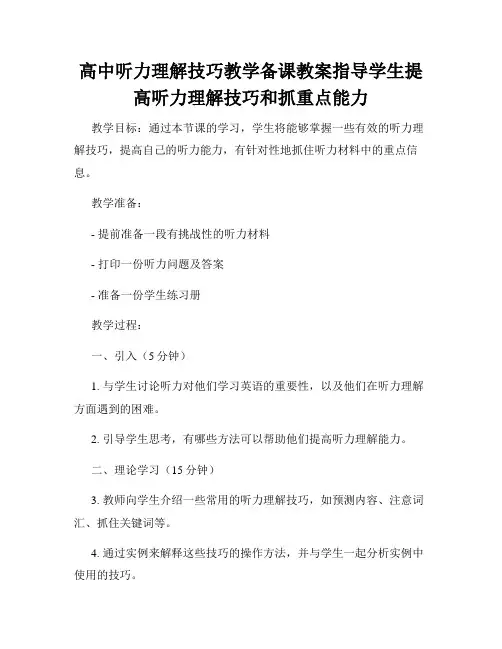
高中听力理解技巧教学备课教案指导学生提高听力理解技巧和抓重点能力教学目标:通过本节课的学习,学生将能够掌握一些有效的听力理解技巧,提高自己的听力能力,有针对性地抓住听力材料中的重点信息。
教学准备:- 提前准备一段有挑战性的听力材料- 打印一份听力问题及答案- 准备一份学生练习册教学过程:一、引入(5分钟)1. 与学生讨论听力对他们学习英语的重要性,以及他们在听力理解方面遇到的困难。
2. 引导学生思考,有哪些方法可以帮助他们提高听力理解能力。
二、理论学习(15分钟)3. 教师向学生介绍一些常用的听力理解技巧,如预测内容、注意词汇、抓住关键词等。
4. 通过实例来解释这些技巧的操作方法,并与学生一起分析实例中使用的技巧。
5. 向学生介绍如何在听力中捕捉重点信息的方法,例如注意修饰词、时间词、数字等。
三、听力训练(25分钟)6. 播放一段具有一定难度的听力材料,要求学生仔细倾听,尽量抓住重点信息。
7. 教师提醒学生可以做一些笔记来帮助记忆重点信息。
8. 听完材料后,教师与学生一起核对答案,讨论学生在听力过程中的困惑和发现的重点信息。
四、巩固练习(20分钟)9. 学生个别或分组进行练习,使用学生练习册上的听力材料进行巩固。
10. 学生完成练习后,教师与学生一起检查答案,并就练习中出现的问题进行讲解和指导。
五、总结和拓展(10分钟)11. 教师对本节课内容进行总结,并强调听力理解技巧的重要性。
12. 提醒学生在日常学习中多加练习,提高听力水平。
13. 引导学生发现更多的听力理解技巧,并鼓励他们在听力实践中不断改进。
教学反思:这节课主要围绕高中学生在听力理解方面的困惑和需要提高的地方展开教学。
通过引入和讨论,激发学生的学习兴趣和参与度。
在理论学习环节,教师结合实例向学生介绍了常用的听力理解技巧,并与学生一起分析实例。
通过听力训练和巩固练习,学生得以实际运用和巩固所学的技巧。
最后的总结和拓展环节帮助学生对所学内容进行归纳整理,并鼓励他们在日常学习中不断尝试和探索更多的听力理解技巧。
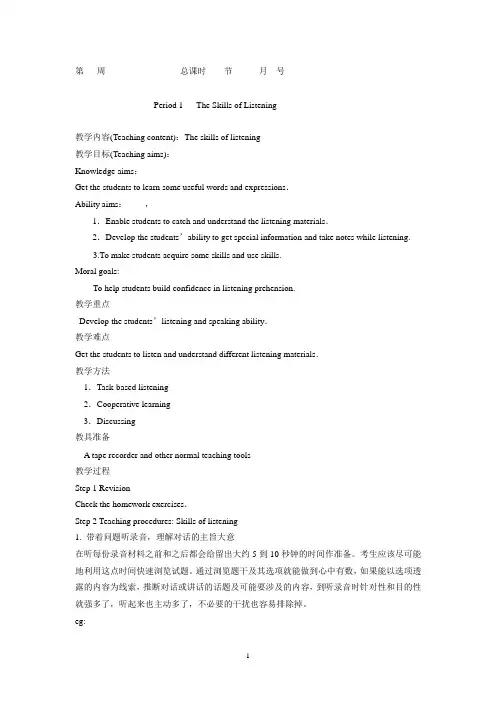
第周总课时节月号Period 1 The Skills of Listening教学内容(Teaching content):The skills of listening教学目标(Teaching aims):Knowledge aims:Get the students to learn some useful words and expressions.Ability aims:,1.Enable students to catch and understand the listening materials.2.Develop the students’ability to get special information and take notes while listening.3.To make students acquire some skills and use skills.Moral goals:To help students build confidence in listening prehension.教学重点Develop the students’listening and speaking ability.教学难点Get the students to listen and understand different listening materials.教学方法1.Task-based listening2.Cooperative learning3.Discussing教具准备A tape recorder and other normal teaching tools教学过程Step 1 RevisionCheck the homework exercises.Step 2 Teaching procedures: Skills of listening1. 带着问题听录音,理解对话的主旨大意在听每份录音材料之前和之后都会给留出大约5到10秒钟的时间作准备。
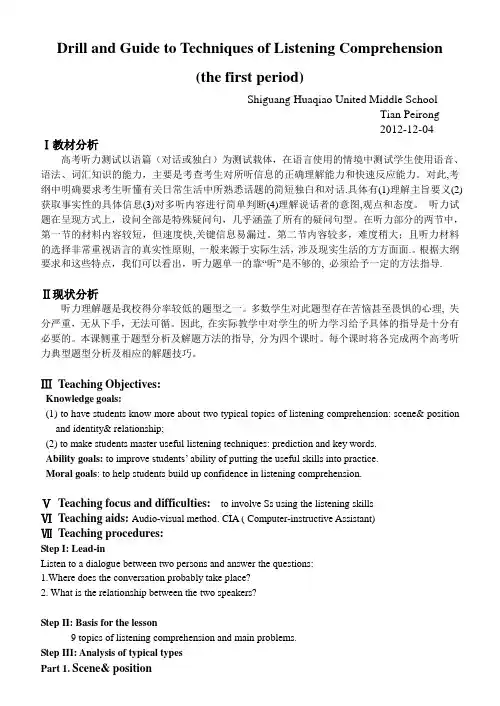
Drill and Guide to Techniques of Listening Comprehension(the first period)Shiguang Huaqiao United Middle SchoolTian Peirong2012-12-04Ⅰ教材分析高考听力测试以语篇(对话或独白)为测试载体,在语言使用的情境中测试学生使用语音、语法、词汇知识的能力,主要是考查考生对所听信息的正确理解能力和快速反应能力。
对此,考纲中明确要求考生听懂有关日常生活中所熟悉话题的简短独白和对话.具体有(1)理解主旨要义(2)获取事实性的具体信息(3)对多听内容进行简单判断(4)理解说话者的意图,观点和态度。
听力试题在呈现方式上,设问全部是特殊疑问句,几乎涵盖了所有的疑问句型。
在听力部分的两节中,第一节的材料内容较短,但速度快,关键信息易漏过。
第二节内容较多,难度稍大;且听力材料的选择非常重视语言的真实性原则, 一般来源于实际生活,涉及现实生活的方方面面.。
根据大纲要求和这些特点,我们可以看出,听力题单一的靠“听”是不够的, 必须给予一定的方法指导.Ⅱ现状分析听力理解题是我校得分率较低的题型之一。
多数学生对此题型存在苦恼甚至畏惧的心理, 失分严重,无从下手,无法可循。
因此, 在实际教学中对学生的听力学习给予具体的指导是十分有必要的。
本课侧重于题型分析及解题方法的指导, 分为四个课时。
每个课时将各完成两个高考听力典型题型分析及相应的解题技巧。
ⅢTeaching Objectives:Knowledge goals:(1) to have students know more about two typical topics of listening comprehension: scene& positionand identity& relationship;(2) to make students master useful listening techniques: prediction and key words.Ability goals: to improve students’ ability of putting the useful skills into practice.Moral goals: to help students build up confidence in listening comprehension.ⅤTeaching focus and difficulties:to involve Ss using the listening skillsⅥTeaching aids: Audio-visual method. CIA ( Computer-instructive Assistant)ⅦTeaching procedures:Step I: Lead-inListen to a dialogue between two persons and answer the questions:1.Where does the conversation probably take place?2. What is the relationship between the two speakers?Step II: Basis for the lesson9 topics of listening comprehension and main problems.Step III: Analysis of typical typesPart 1. Scene& positionCommon Questions:Where does / did this conversation probably take place?Where are the two speakers?Example1. Where does the conversation most probably take place? (08全国5)A. In a restaurantB. In an officeC. At homeSkill a: Catch the key words related to scene and position.Example2. Where are the two speakers going to plant the tree? (09/1)A. By the front doorB. At the back of the garageC. At the end of the gardenSkill b: pay attention to positive and negative responses or expressions; such as: Yes/ Absolutely/ I agree with you...;No/ I’m not sure...【PRACTICE】1. Where does this conversation probably take place? (2012全国1. )A.In a bookstoreB.In a classroomC. In a library2. Where does the conversation most probably take place? (2011重庆3)A. In a restaurantB. On a farmC. At home3.Where are the speakers? (2010全国5)A. In a storeB. In a classroomC. At a hotel4. Where does the conversation probably take place? (09北京5)A. In a classroomB. In a libraryC. In a bookstore5. Where are the speakers? (2009全国2)A. In a restaurantB. In a hotelC. In a school6.Where does the conversation most probably take place?(08湖北1)A. In an officeB. In a libraryC. In a bookstore7. Where will the swimming competition be held? (08天津83独白)A. At the school swimming poolB. At the Jackson Sports CenterC. At the New Town Swimming PoolPart 2.Identity & relationshipCommon Questions:What is the man(woman)?What is the man's (woman's)job/occupation/profession?Who is the man(woman)most probably speaking to?What's the relationship between the two speakers?Example1: Who is Chris Paine?A. A computer engineerB. A book sellerC. A writerSkill a: Catch the key words related to occupation/identity.Example2. Between whom did this dialogue probably take place?A .husband and wife B. teacher and student C. doctor and patient Skill b: Analyze the options and predict the relationship.【PRACTICE】Ex1. Listen to the dialogues and choose the answers:1. Who is the woman?A. A teacherB. An assistantC. A student2. Who do you guess is talking with the man ?A. His mother. ]B. His boss.C. His friend.3. Between whom did this dialogue probably take place?A. Husband and wifeB. Teacher and studentC. They are strangers.Ex2. (2011北京Text7)1. What is the probable relationship between the two speakers?A. Husband and wife.B. Doctor and patient.C. Guest and receptionist.2. Where does this conversation probably take place?A. At a clinicB. At homeC. At a hotelEx3. (2010全国Text8)1. Who is making the telephone call?A. Thomas Brothers.B. Mike Landon.C. Jack Cooper.2. What relation is the woman to Mr.Cooper?A. His wife.B. His boss.C. His secretary.Step IV: SummaryStep V: Homework《维克多英语》P18 谈话背景、谈话者关系练习。
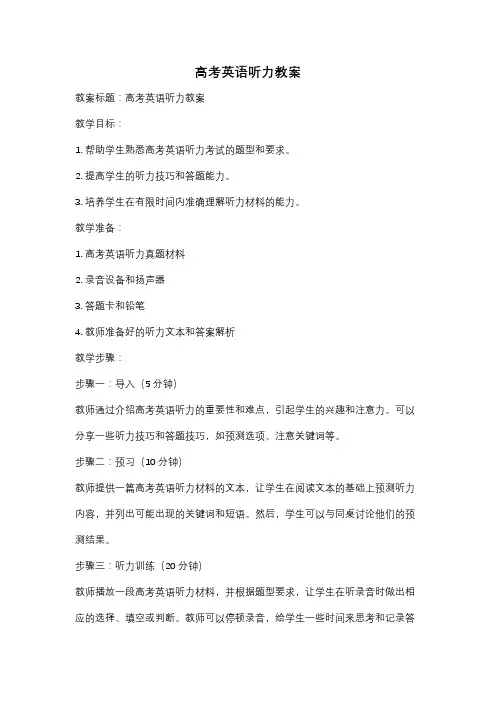
高考英语听力教案教案标题:高考英语听力教案教学目标:1. 帮助学生熟悉高考英语听力考试的题型和要求。
2. 提高学生的听力技巧和答题能力。
3. 培养学生在有限时间内准确理解听力材料的能力。
教学准备:1. 高考英语听力真题材料2. 录音设备和扬声器3. 答题卡和铅笔4. 教师准备好的听力文本和答案解析教学步骤:步骤一:导入(5分钟)教师通过介绍高考英语听力的重要性和难点,引起学生的兴趣和注意力。
可以分享一些听力技巧和答题技巧,如预测选项、注意关键词等。
步骤二:预习(10分钟)教师提供一篇高考英语听力材料的文本,让学生在阅读文本的基础上预测听力内容,并列出可能出现的关键词和短语。
然后,学生可以与同桌讨论他们的预测结果。
步骤三:听力训练(20分钟)教师播放一段高考英语听力材料,并根据题型要求,让学生在听录音时做出相应的选择、填空或判断。
教师可以停顿录音,给学生一些时间来思考和记录答案。
每段录音播放后,教师可以播放一遍录音供学生核对答案,并进行答案解析。
步骤四:反思与总结(10分钟)教师与学生一起回顾本节课的听力训练,讨论学生在听力过程中遇到的困难和解决方法。
教师可以分享一些听力技巧和答题技巧,帮助学生更好地应对高考英语听力考试。
步骤五:拓展练习(15分钟)教师提供一些额外的高考英语听力练习题,让学生在课后继续巩固和提高听力技巧。
学生可以在课后自主完成,并将答案带到下一节课上与教师和同学一起讨论。
教学评估:教师可以通过学生的课堂表现、课后练习的完成情况和答案的准确性来评估学生的听力水平和答题能力。
同时,教师也可以根据学生的反馈来调整教学内容和方法,以提高教学效果。
教学延伸:教师可以组织学生参加模拟高考英语听力考试,提供真实的考试环境和题型,帮助学生更好地适应高考英语听力考试的要求。
此外,教师还可以推荐一些相关的听力资源和练习材料,供学生自主学习和提高听力水平。
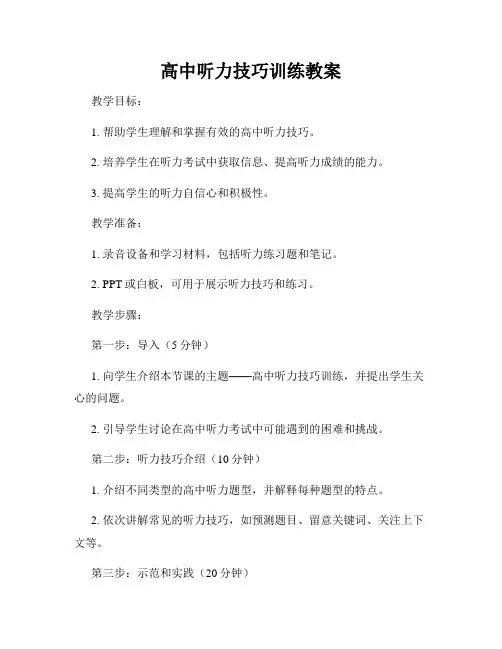
高中听力技巧训练教案教学目标:1. 帮助学生理解和掌握有效的高中听力技巧。
2. 培养学生在听力考试中获取信息、提高听力成绩的能力。
3. 提高学生的听力自信心和积极性。
教学准备:1. 录音设备和学习材料,包括听力练习题和笔记。
2. PPT或白板,可用于展示听力技巧和练习。
教学步骤:第一步:导入(5分钟)1. 向学生介绍本节课的主题——高中听力技巧训练,并提出学生关心的问题。
2. 引导学生讨论在高中听力考试中可能遇到的困难和挑战。
第二步:听力技巧介绍(10分钟)1. 介绍不同类型的高中听力题型,并解释每种题型的特点。
2. 依次讲解常见的听力技巧,如预测题目、留意关键词、关注上下文等。
第三步:示范和实践(20分钟)1. 播放一段录音,让学生根据已学的听力技巧尝试回答相关问题。
2. 请几位学生上台展示听力技巧的应用,并提供反馈和指导。
第四步:练习与巩固(20分钟)1. 分发听力练习题,并要求学生在规定的时间内完成。
2. 播放录音,让学生根据听力技巧回答问题,并核对答案。
3. 分析和讨论学生在练习中的常见错误和不足之处,并给予指导。
第五步:总结与扩展(10分钟)1. 总结本节课学习的高中听力技巧,并强调其在提高听力成绩中的重要性。
2. 鼓励学生在日常学习中锻炼听力技巧,如多听英语材料、参加听力竞赛等。
3. 提供相关的学习资源和推荐的网站或应用程序。
第六步:作业布置(5分钟)1. 布置听力作业,要求学生根据所学技巧完成听力练习题。
2. 强调学生复习和巩固所学的听力技巧,以提高听力水平。
教学评估与反馈:1. 教师对学生的听力练习进行评估,检查并反馈每个学生的学习进展。
2. 根据学生的学习情况,提出改进建议和辅导措施。
教学延伸:1. 组织学生进行听力竞赛,激发他们的听力兴趣和动力。
2. 鼓励学生积极参加英语角或其他英语实践活动,提高听力和口语能力。
这个教学方案旨在帮助高中学生掌握有效的听力技巧,并提高他们的听力水平和考试成绩。
高考听力训练教案
教案标题:高考听力训练教案
一、教学目标:
1. 熟悉高考听力考试的题型和要求;
2. 提高学生的听力理解能力,包括听取信息、理解主旨和细节等方面;
3. 培养学生的听力策略和技巧,提高应对高考听力考试的能力。
二、教学重点和难点:
1. 重点:了解高考听力考试的题型和要求,掌握听力技巧;
2. 难点:提高学生的听力理解能力,培养学生的听力策略。
三、教学内容和过程:
1. 熟悉高考听力考试的题型和要求,包括听对话、听短文和听长对话等;
2. 分析高考听力考试的常见题型,如选择题、填空题和判断题等;
3. 引导学生掌握听力技巧,如预测信息、注意关键词和上下文推测等;
4. 练习高考听力考试的模拟题目,包括听力材料的播放和答题技巧的训练;
5. 分析学生在听力训练中的问题和不足,针对性地进行指导和训练。
四、教学方法和手段:
1. 听力材料的播放和训练;
2. 分组讨论和合作学习;
3. 教师讲解和学生练习相结合;
4. 利用多媒体设备和教学软件进行教学。
五、教学评价:
1. 学生听力训练的成绩和进步;
2. 学生对听力策略和技巧的掌握程度;
3. 学生在模拟考试中的表现和成绩。
六、教学反思:
1. 分析学生在听力训练中的问题和困难;
2. 总结教学方法和手段的有效性和不足;
3. 调整和改进教学策略,提高学生的听力训练效果。
高中英语听力技巧教案设计听力是英语学习的重要部分之一,也是学生在英语学习中相对薄弱的部分,如何让学生更好地掌握听力技巧,提高他们的听力水平,是语言教学中需要重点关注的问题之一。
本教案将从听力训练的目标、步骤、原则等多方面进行系统而详细的介绍,帮助教师更好地开展高中英语听力训练。
I. 教学目标1. 掌握提高英语听力技巧的方法和技巧;2. 开发学生对英语的兴趣,提高学生学习英语的积极性;3. 培养学生的听力技能,在不用听到课文多次的情况下,准确地理解英语听力材料,提高英语应试能力。
II. 教学步骤1. 教学前教师需要给学生讲解英语听力以及提高听力技巧的必要性,让学生理解到听力水平的重要性和提高听力水平的积极性。
2. 教学中(1) 遵循英语听力技巧的基本原则1)注意听。
学生应该时刻保持专注,不被周围的声音所干扰,集中注意力,在一个良好的听力环境中进行听力训练,提高听力水平。
2)预测内容。
学生可以通过对前文的了解和预测,大概了解下一句话要说的内容,有助于准确听到并理解到句子的意思。
3)记笔记。
学生在听语音过程中,可以尝试使用笔记记录下一些关键词汇或重点内容,可以帮助他们在听完后快速复习所听到的内容。
(2) 具体注意事项在进行听力训练过程中,除了上述基本原则外,还需要注意一些具体的听力技巧,如:1)强调每个词汇的发音,特别是元音;2)学会识别口语化的语言表达方式,比如缩略语、俚语等;3)理解重读音节的含义和强调重读的重要性;4)掌握固定搭配的含义,从而加深理解力。
(3) 练习技巧在学生进行听力训练的过程中,教师需要对学生进行指导,让他们掌握一些有效的练习技巧,如:1)有效的听力训练是必要的,这需要学生通过大量的阅读、听力材料练习、模拟实际情境等方式进行;2)测试前的有效训练,可以帮助学生更好地理解和复习所听到的内容;3)准确的听力材料是非常重要的,因为如果学生无法听到合适的内容,将很难提高他们的听力技巧。
高考英语听力技巧教案一、教学目标1. 让学生掌握高考英语听力考试的题型和答题技巧。
2. 提高学生的英语听力理解能力,尤其是对于日常对话、故事情节、讲话和叙述的听力技巧。
二、教学内容1. 高考英语听力题型分析:对话、短文理解和长对话。
2. 听力技巧讲解:预测、关键词定位、信息整合和笔记。
3. 听力练习:各类题型的听力练习和答题技巧训练。
三、教学过程1. 第一课时:介绍高考英语听力考试的题型和答题技巧。
a. 分析对话题型,讲解答题技巧。
b. 分析短文理解题型,讲解答题技巧。
c. 分析长对话题型,讲解答题技巧。
2. 第二课时:听力技巧讲解。
a. 预测:如何根据题目和选项预测答案。
b. 关键词定位:如何找到关键词并快速定位答案。
c. 信息整合:如何将听到的信息进行整合和归纳。
d. 笔记:如何边听边做笔记,帮助答题。
3. 第三课时:听力练习。
a. 对话题型练习:让学生进行对话听力练习,培养答题技巧。
b. 短文理解题型练习:让学生进行短文听力练习,培养答题技巧。
c. 长对话题型练习:让学生进行长对话听力练习,培养答题技巧。
四、教学评价1. 课后作业:布置相关听力练习题,让学生巩固所学技巧。
2. 课堂表现:观察学生在课堂上的参与程度和听力技巧的掌握情况。
3. 练习反馈:收集学生的练习成果,进行批改和反馈。
五、教学资源1. 教学PPT:展示听力题型和答题技巧。
2. 听力材料:提供各类题型的听力练习材料。
3. 练习册:提供配套的听力练习题。
教学反思:六、教学策略1. 采用任务型教学法,让学生在实际听力练习中掌握技巧。
2. 运用合作学习法,让学生分组讨论,共同解决问题。
3. 运用情境教学法,模拟真实听力场景,提高学生的实际应用能力。
七、教学注意事项1. 注重学生的个体差异,因材施教,使每个学生都能在课堂上得到锻炼和提高。
2. 鼓励学生积极参与课堂活动,培养学生的自信心和勇气。
3. 注重培养学生的听力习惯,提醒学生在日常生活中多听、多练习。
高考听力教案教案标题:高考听力教案教学目标:1. 帮助学生掌握高考听力考试的技巧和策略。
2. 提高学生的听力理解能力,使其能够准确理解和应对高考听力材料。
3. 培养学生的听力答题技巧,提高他们在高考听力考试中的得分。
教学准备:1. 高考听力材料2. 录音设备和播放器3. 课堂黑板和白板4. 学生练习册和答题卡教学过程:步骤一:导入1. 向学生介绍高考听力考试的重要性和对学生大学录取的影响。
2. 引导学生讨论他们在高考听力考试中遇到的困难和挑战。
步骤二:讲解听力技巧和策略1. 向学生介绍常见的高考听力题型,如听力填空、听力选择等。
2. 解释每种题型的要求和答题技巧,例如,如何根据关键词来填写空格,如何通过上下文推断正确答案等。
3. 提供实例让学生理解和练习每种题型的答题方法。
步骤三:练习和评估1. 播放一段高考听力材料,让学生跟随录音进行听力理解。
2. 分发练习册和答题卡,让学生根据听力材料完成相应的题目。
3. 检查学生的答案,解释正确答案和解题思路。
4. 鼓励学生讨论和分享他们在听力过程中的困难和发现的解题技巧。
步骤四:巩固和拓展1. 提供额外的高考听力材料,让学生在课后进行练习。
2. 鼓励学生利用多种资源,如英语听力材料、电视节目等,来提高他们的听力水平。
3. 引导学生总结和记录他们在听力过程中遇到的问题和解题技巧。
步骤五:反思和总结1. 与学生一起回顾本节课的学习内容和收获。
2. 鼓励学生提出问题和反馈意见,以便改进教学方法和教案设计。
教学扩展:1. 组织模拟高考听力考试,让学生在真实的考试环境中进行练习和评估。
2. 鼓励学生参加英语角、英语演讲比赛等活动,提高他们的听力和口语能力。
教学评估:1. 通过学生的课堂表现、练习册答案和模拟考试成绩来评估他们的听力理解和答题能力。
2. 收集学生的反馈和意见,以评估教学效果和教案的可行性。
教学延伸:教师可以根据学生的实际情况和需求,进一步提供个性化的听力辅导和指导,帮助他们克服听力难题,提高他们的高考听力成绩。
《听力训练与解题技巧指导》教学设计一、教学内容分析听力在英语高考试卷中占30分的分值,所涉及的话题主要有学习生活、家庭生活、个人爱好、天气、时间、数字、地点、健康、购物、文化娱乐、体育、租房、旅游、交通等,可谓是涉及到生活中的方方面面。
高考听力题既考查听的能力,又考查考生阅读、理解、逻辑判断的能力和心理承受能力。
要求学生具备听的能力,扫视题干的能力及迅速判断的能力,需要这三者能力结合并在最短的时间内做出正确的选择。
同学们能否在这部分测试中取得好成绩,关键就在于能否掌握并运用一定的听力技巧。
二、学情分析高三学生虽然已经做了大量的听力练习,但仍然存在问题:有的学生一遇到听力就紧张,不能集中精力去捕捉考题信息;有的学生容易在与数字、地点等有关的典型题目上丢分;有的学生则缺乏好的解题方法和技巧,得分不稳定。
因此,本课侧重于题型分析及解题技巧的指导,帮助学生增强信心,减少失误,提高得分率。
三、教学目标分析Knowledge goals:1. to have students know more about four typical topics of listening comprehension: scene, identity& relationship, inference and the author’s attitude&opinion.2 . to make students master useful listening techniques: prediction and key words. Ability goals: to improve students’ ability of putting the useful skills into practice. Moral goals: to help students build up confidence in listening comprehension.四、教学重点、难点分析重点:1.让学生掌握在听力过程中应注意的问题以及典型题目的解题技巧。
公立高中教案:英语听力技巧与训练一级标题:英语听力技巧与训练第一段:引言英语听力是学习英语的重要组成部分,掌握有效的听力技巧和训练方法对于提高听力水平至关重要。
本文将介绍一些有效的英语听力技巧和训练方法,帮助公立高中的学生提高他们的英语听力能力。
二级标题1:预备阶段:创造良好的听力环境第二段:提供真实、多样的听力材料为了培养学生对不同音频材料的适应能力,教师们应提供真实、多样的听力材料,如英语电影、音乐、广播节目和纪录片等。
这些材料能够帮助学生熟悉不同的语速、口音和语言风格。
第三段:营造英语学习氛围在课堂以外的环境中,教师还可以鼓励学生听英语音乐、观看英语电影或与外国人交流。
通过这些交流和体验,学生们能够增加他们的接触面,提高他们对英语的理解能力。
二级标题2:训练方法:提高听力技巧第四段:活跃的课堂讨论在课堂上,教师应鼓励学生参与活跃的讨论。
通过讨论,学生们可以学习到不同的观点和思维方式,并提高他们对不同口音和语速的理解能力。
教师可以通过提问、举例和小组讨论等活动来激发学生们的参与。
第五段:听力任务与练习为了提高学生听力技巧,教师可以设计各种不同类型的听力任务和练习。
这些任务和练习可以涵盖不同的主题和语言风格,例如填空、选择、排序和听写等。
通过这些练习,学生们可以在实际的听力环境中提高他们的技巧。
第六段:使用辅助工具现代技术提供了许多辅助工具来改善学生的听力技巧。
例如,教师可以使用录音设备进行听力录音,然后与学生一起进行听力分析和反馈。
此外,教师还可以使用在线语音识别软件和听力App等辅助工具,帮助学生更好地训练和评估他们的听力能力。
二级标题3:常见问题及解决方法第七段:识别生词和短语在听力中,生词和短语是学生们经常遇到的问题。
为了解决这个问题,教师可以提供生词表和短语表,帮助学生在听力过程中更好地识别和理解这些单词和短语。
第八段:提高听力速度对于许多学生来说,听力速度是一个难点。
为了提高学生的听力速度,教师可以将听力材料划分为不同的部分,逐渐提高难度和语速。
听力训练与解题技巧指导(Ⅰ)学案Step I: Warming-up & Lead-in1.Where does the conversation most probably take place?A. In an officeB. In a libraryC. In a bookstore2. What are the two speakers talking about?A. A football playerB. A football teamC. A football match3. What does the woman think of the man’s English?A. ExcellentB. AcceptableC. Strange解题步骤1、听前(pre-listening) →审题,预测2、听时(while-listening) →细听,记录3、听后(post-listening) →判断,选择Key:遵循解题步骤,勤加练习,熟悉题型,掌握答题技巧等。
Step II: Basis for the lesson高考听力材料的选用非常重视语言真实性和交际性的原则,语言材料一般来源于实际生活, 对话的内容大都取材于日常生活, 即衣、食、住、行、工作、学习、天气、生活环境等话题, 可分为校园、公共场所、家庭等方面,如:shopping, finding the way, doing one\'s homework, seeing a doctor, making等。
要求考生听懂有关日常生活中所熟悉话题的简短独白和对话, 考生应能(1) 理解主旨要义; (2)获取事实性的具体信息;(3)对多听内容进行简单判断; (4)理解说话者的意图,观点和态度;常见提问形式有:Where does / did this conversation probably take place?Where are the two speakers?Where can you see such plants?题型特点:此类题的书面选项大都是表示地点或方向的介词短语,主要考查分析推理能力,即根据对话所提供的信息,推断出对话所发生的地点和场景。
1. Where does the conversation most probably take place?A. In a restaurantB. In an officeC. At homeSkills:a. 仔细辨认对话中的语境相关词,特别是场景词汇及习惯用语.2. Where are the two speakers going to plant the tree?A. By the front doorB. At the back of the garageC. At the end of the gardenSkills: b.注意对话中肯定与否定回答. 例如常见的肯定回答: Yes/ Absolutely/ I agree with you…否定回答: No/ I’m not sure….练习:1. Where does the conversation probably take place?A. In a classroomB. In a libraryC. In a bookstore2. Where are the speakers?A. In a restaurantB. In a hotelC. In a school3. Where will the swimming competition be held?A. At the school swimming poolB. At the Jackson Sports CenterC. At the New Town Swimming Pool常见提问形式有:What's the relationship between the two speakers?Who is the man(woman)most probably speaking to?What is the man(woman)?What is the man's (woman's)job/occupation/profession题型特点:对话中不会直接提到职业或关系, 只会用一些相关词作暗示。
主要考查能否根据对话内容、语气及说话者的态度做出正确的判断。
1. Who is Chris Paine?A. A computer engineerB. A book sellerC. A writerSkills:a.仔细辨认对话中的职业相关词, 抓住其相关的关键词进行答题。
2. Between whom did this dialogue probably take place?A. husband and wifeB. teacher and studentC. doctor and patientSkills: b.分析选项目,预测可能出现的词汇,短语,句子。
细听,捕捉关键消息判断人物的职业,身份及人物关系。
练习:1. What do you think the woman is?A. A doctorB. A nurseC. A waitress2. What is the probable relationship between the two speakers?A. Manager and job applicant.B. Teacher and student.C. Professor and teaching assistant(预测关系trouble、check、pain、sore((发炎)疼痛的;酸痛的)、fever、heart、stomach、lungs、blood test、prescription、when did it start、open your mouth, what’s wrong with you?...professor, subject, homework, questions, major(专业),hand in, why are you late? …size、color、try on、price、discount、Can I help you?What size do you wear?Is that cash or charge?……dear、darling、sweetheart、my love、cook、picnic、TV、dinner……常见提问形式有:What does the man(woman) mean?What do we learn from the conversation?Why is the woman so happy?What does the man (woman) imply?What can be inferred from the conversation?题型特点:说话人表达思想的方式比较含蓄,往往不能为选择答案提供直接的信息。
1. What does the woman mean?A. She didn’t tell a lie.B. She doesn’t tell the truth.C. She didn’t choose to talk to the man.Skills:a.从间接回答中理解言外之意.b.特别注意对话中的提示词、语气、语调。
降调通常表示讲话人的态度是肯定、赞同的2. What does the man mean?A. He had a terrible vocation.B. He remained at home all the time.C. The woman asked a silly question.Skills: c.注意一些语法的运用,如虚拟语气表示与事实相反, 否定比较级结构表示最高级;It couldn’t be better. I couldn’t agree more. …;定语从句对人和事进一步修饰。
如: She is the person who is always speaking ill of others.练习:1. What does the woman mean?A. Cathy will be at the partyB. Cathy is too busy to comeC. Cathy is going to be invited2. What does the woman imply?A. The man is so forgetful.B. The man is too careless.C. The man is over confident.3. What do we know about the girl?A. She is new to the school.B. She writes for the school newspaper.C. She seldom asks questions in class.常见提问形式有:What does the man(woman)say about/think of...?How does the man(woman) feel/ like about...?What's the man's(woman's) opinion about...?题型特点:根据对话者说话的语音、语调、语气以及谈话内容,判断出说话者对某人、某事物的看法或态度。
1. What does the man think about the vacation?A. It’ll be a long vacation.B. It’s only a dream.C. It’ll be great.Skills:a.细辨表示观点的形容词, 推断出谈话人的意图和看法。
2. What does the man think of Picasso?A. He thinks that he is the greatest Spanish painter.B. He doesn’t consider him the best Spanish painter.C. He is sure that he can become famous.Skills: 注意两个人的态度是否相同,如果不同,要分清各人的态度,因为这时问题往往问的是其中一人的态度或看法,不要混淆。